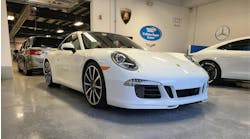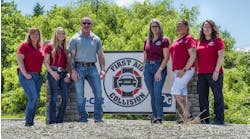Wavy rotors will make even your best customers say goodbye.
Automakers have been forced to re-engineer many components on their vehicles to meet federal fuel efficiency regulations. Rotors are obvious examples of this fact. Today's rotors are noticeably thinner and lighter.Consequently, there's little difference between a new disc and its "discard" specification, and many brand-new modern rotors are at a disadvantage compared to their predecessors – even some nearly worn-out old ones – in terms of absorbing and dissipating heat.
Thinness has other consequences: Unnecessarily cutting a rotor that's not thick to start with appreciably shortens its useful life. Also, these thinner rotors are more easily warped; their lack of mass makes them less able to damp vibrations making noise easier to generate; and their lowered capacity to dissipate heat makes them more prone to brake fade.
UNIFORM THICKNESS IS A MUST
Pedal pulsation results from disc thickness variation (DTV). This develops over time; you shouldn't notice it on a post-servicing test drive and it won't be there when customers pick up their vehicles.Nevertheless, the conditions causing it may already be present. Sadly, they're often technician-induced.
DTV inevitably results from rotor runout. Even a rotor with perfectly parallel working surfaces may not run true, and a warped rotor can never run true. By definition, it's got built-in runout.
There's a funny thing about calipers and pads: They hide rotors with runout from the driver and turn them into unevenly thick ones.
Here's how it happens. As a rotor with runout spins with the moving vehicle, it presents waves of high and low areas to the adjacent pads. But the driver won't notice any odd feel in the brake pedal as long as the rotor's thickness is even. This is because floating calipers slide in and out with a rotor's waves as they pass through.
With fixed-position calipers, fluid displaced from the "high" side just moves behind the piston(s) on the "low" side.Thickness variation develops while the vehicle is moving with the brakes unapplied. As high spots pass, they contact the pad, which misses the low spots. The pad may just gently rub those high spots so wear is gradual, but the erosion that formed the Grand Canyon was gradual, too.
Eventually, the high spots become thin spots. In as little as 3,000 to 5,000 miles, the rotor's non-parallel surfaces begin acting as ramps, spreading the pads apart as thick sections pass through, then letting them clamp together as the thin parts slip by.
This causes a back-and-forth motion in the caliper pistons that moves brake fluid back-and-forth between the caliper and master cylinder. The driver feels it as a throbbing in the brake pedal. You feel it in your wallet as a time-wasting comeback.
RUNOUT AVOIDANCE
Any more than -0.0005 inch (half a thousandth) of runout may lead to DTV that will be perceptible in the brake pedals of some vehicles. While 0.001 inch to 0.002 inch may be a more common standard, it's still obvious that a true rotor is your true friend.As Wally Marciniak, head of Technical Training at Affinia Group's Ray bestos Brakes, points out, you're asking for trouble if you take even new, top-quality rotors out of their boxes, slip them onto a clean hub with good wheel bearings, hang a pair of quality loaded calipers and send the customer home.
One reason is that, in Marciniak's words, "The 'tolerance stack' can get you." The rotor may be slightly off – an acceptable amount – and the hub may be, too. But if the high spots, for example, are lined up, that perfectly good rotor could run out excessively.
"The technician," he says, "will naturally suspect the rotor, even though there's nothing wrong with it."
"You won't know if you're on spec unless you measure every time," says Honeywell Friction Materials' Bendix Brake Answerman Jay Buckley. "Check with a dial indicator reading near the outer edge of the rotor's pad contact surface after snugging the rotor down."Use at least three lug nuts (for five-lug wheels) or two nuts (for four-lug wheels.) It might be necessary to invert the nuts or use washers to hold the rotors sufficiently.
The only time remeasuring may not be necessary is when reinstalling a rotor that has already been measured and found on-spec was mated cleanly with the hub previously; the parts remain corrosion-free and clean; and the hub and rotor were index-marked to ensure being mated in the same relative positions.
If stacked tolerances are causing excessive runout, a rotor often may be brought into spec by "clocking": slipping it off, turning it to the next lug position, then retightening and re checking. If no position yields acceptable runout the rotor (or hub) may be damaged or defective; loose wheel bearings are also a possibility.
The big reason most manufacturers insist on using on-car lathes is that unless the lathe is defective or operated improperly and if the wheel bearings are OK, the finished rotor should run true. Chrysler, in fact, is so insistent on this that at least one technical service bulletin (TSB) told dealers without on-car lathes to farm out certain jobs to shops that had them.
General Motors (GM) is the main holdout; they endorse the use of "runout correction plates," which are tapered shims made to fit over the lug studs between the inside of the rotor hat and the hub. A major GM argument in favor of these is that the various tapers available often enable a technician to true up a rotor without needing to cut it, retaining as much thickness as possible while keeping the surface intact if it's either new or good to go as-is.
RESURFACING
Both Buckley and Marciniak stress the importance of smooth rotor surfaces in providing smooth, quiet stopping power, as well as in minimizing dusting. If you can measure 15/80 RA, that's the standard you want. Lathe swirl attachments and "flex hones" can help achieve this figure. But one method that's simple and effective is to hold a sanding block holding 120 to 150 grit paper while it's turning on a lathe for 60 seconds per surface.
Brake dust is just what the name implies: powdered remains of both pads and rotors. Pad choice – not just pad type, but quality – can impact the severity of dusting. Consider it a case of getting what you pay for: Buckley says cheap rotors often are more easily "powdered" than discs with good metallurgy and that higher-quality pads tend to take less of a toll on rotors.
Because modern rotors are already thin, do not turn them unless necessary. This isn't just because allowing rotors to stay as thick as possible helps preserve service life; it's also because initial stopping power will be better.
There's nothing magic about performing brake work that keeps the customer satisfied. It's mostly a matter of knowing what needs to be done before you start, installing quality, appropriate components, not skipping steps – and knowing what the new steps are as specs and recommendations change.

